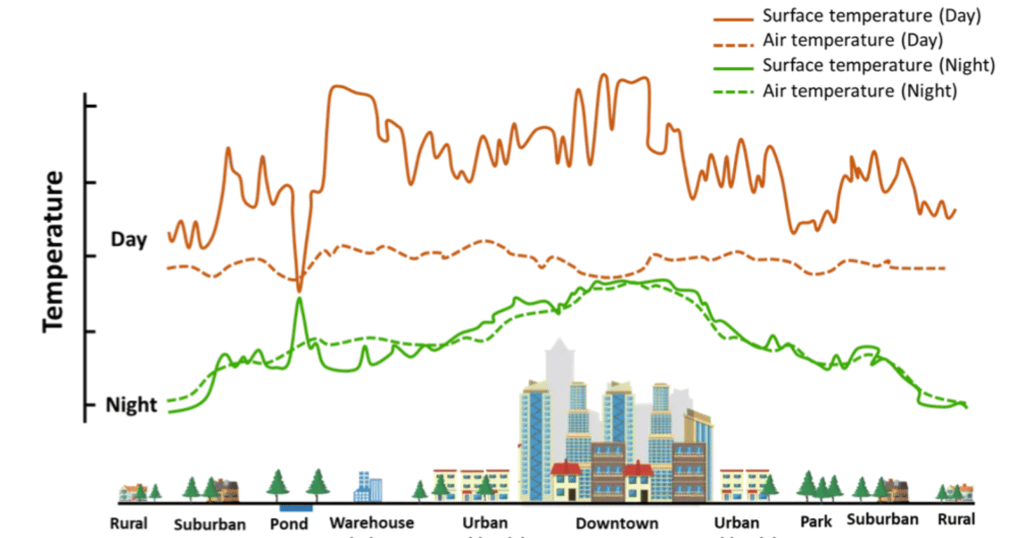Urban Heat Islands: Causes and Mitigation Efforts
DEAR JAKARTA, 2050ENVIRONMENTAL WATCH
Syakirah Ailsa Rabbanie
10/19/20252 min read


My skin burning? An ocean’s worth of sweat for just being outside an air-conditioned room for five minutes? Everything and everybody smelling like the sun? Well, if you live in Jakarta, then congratulations! You are not a stranger to these everyday occurrences.
But then you think, “This city is getting way hotter than usual. Let's take a healing trip somewhere refreshing like Tangerang”. And then it's just like what you expected, the air in Tagelang feels way more refreshing and cool compared to Jakarta. But have you ever wondered why it is like that? Why is the sun not as cruel to Tangerang as it is to Jakarta?
Well good news, the sun is not the one to blame. Bad news, this phenomenon falls under the “Urban heat island” (UHI) phenomenon, where cities that are no strangers to rapid population growth experience much warmer temperatures than nearby rural areas.
With an area of 661.23km², 12.662 million inhabitants, and an average population density of 16,000 per km², Jakarta’s development needed to adapt to the rapid population growth of the city. A common construction pattern carried out was the conversion of water bodies into non-vegetated areas such as settlements and buildings.
However, this pattern has caused the expansion of hot and dry areas from the lack of Urban green spaces, heat absorbed by the large volumes of concrete & asphalt used in construction, and tall buildings blocking wind flow, further trapping heat within the urban area. This serves Jakarta as one of the worst cases of Urban heat island.
Public awareness has been advocated by the community, especially by the Jakartan and the Indonesian youths in general, as we, and the next generation will be hit the hardest by this phenomenon if nothing is done to reduce it.
Dwikorita Karnawati, the head of the Indonesian Agency for Meteorology, Climatology, and Geophysics (BMKG), has been vocal about ways the youth can mitigate UHI, such as using social media platforms to raise UHI awareness, planting trees in urban areas, and starting urban gardening.
Although these are important efforts in mitigation, The Ministry of Environment and Forestry's (KLHK) implementation of Urban Heat Island mitigation programs still faces various challenges, particularly in terms of inter-agency coordination and suboptimal public participation. Further emphasising the need for us, the young generation, to start taking action now.
The clock is ticking for Jakarta as projections for 2040 indicate that the area affected by UHI will expand to 44,481.31 hectares, essentially encompassing the entire city. It is up to us to make the change.
Works Cited
Fabiola Candraningtyas, Callista, et al. “Urban Heat Island Distribution, Transformation, and Projection (Case Study: Jakarta City in 2000, 2020, and 2040).” BIO Web of Conferences, vol. 155, 2025, p. 03002, https://doi.org/10.1051/bioconf/202515503002. Accessed 11 Mar. 2025.
Fajardin, Mohammad Atik. “Generasi Muda Dinilai Punya Peran Mitigasi Urban Heat Island.” SINDOnews Nasional, SINDOnews.com, 28 June 2024, nasional.sindonews.com/read/1405363/15/generasi-muda-dinilai-punya-peran-mitigasi-urban-heat-island-1719576371. Accessed 31 Aug. 2025.
“Jakarta Population 2025.” Worldpopulationreview.com, 2025, worldpopulationreview.com/cities/indonesia/jakarta#city-size-and-population-density.
MAPID. “[GEODATA] Urban Heat Island.” Mapid.co.id, 30 Nov. 2023, mapid.co.id/blog/geodata-urban-heat-island. Accessed 31 Aug. 2025.
Putra, C D, et al. “Increasing Urban Heat Island Area in Jakarta and It’s Relation to Land Use Changes.” IOP Conference Series: Earth and Environmental Science, vol. 737, no. 1, 1 Apr. 2021, p. 012002, https://doi.org/10.1088/1755-1315/737/1/012002.
